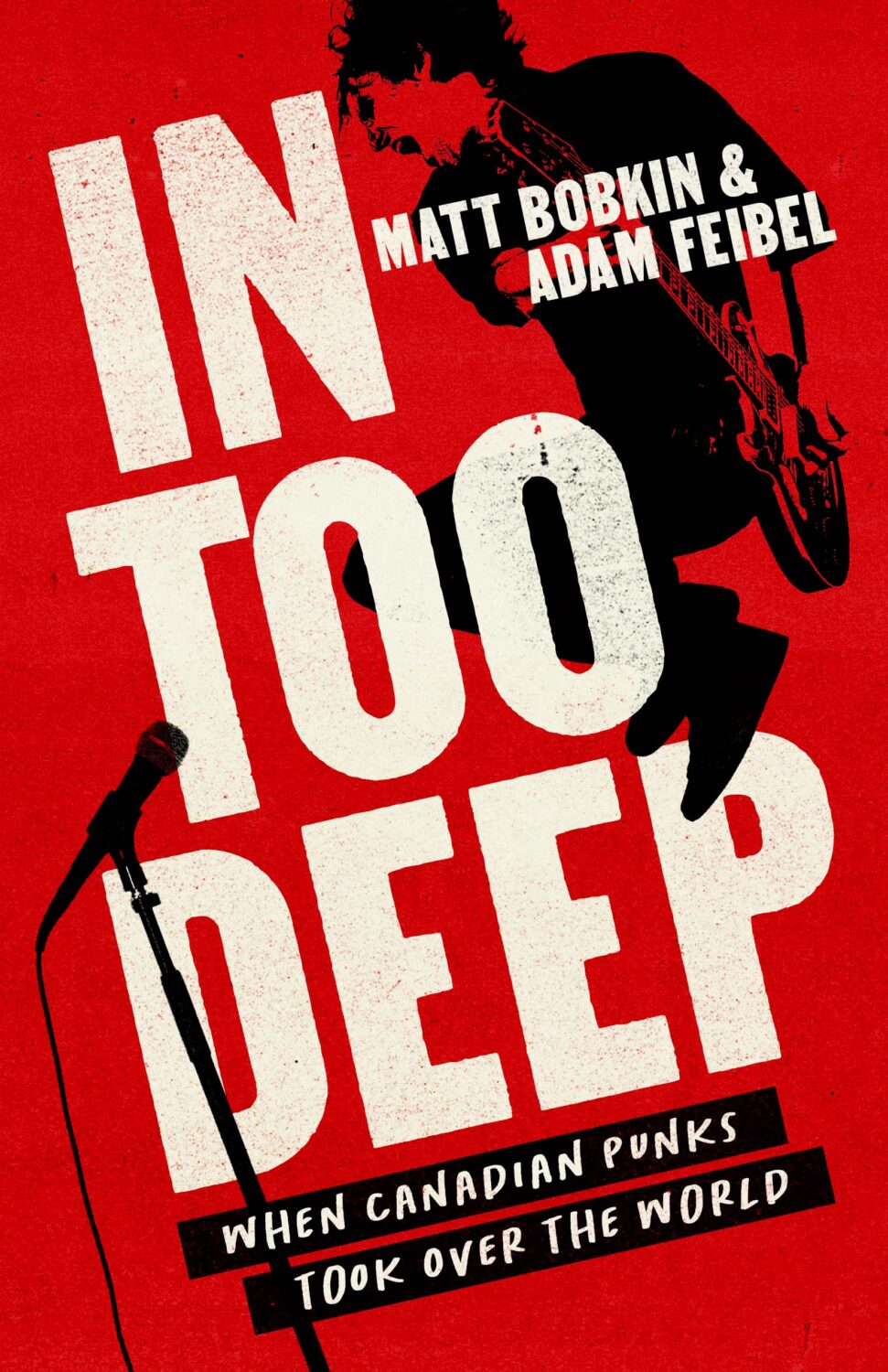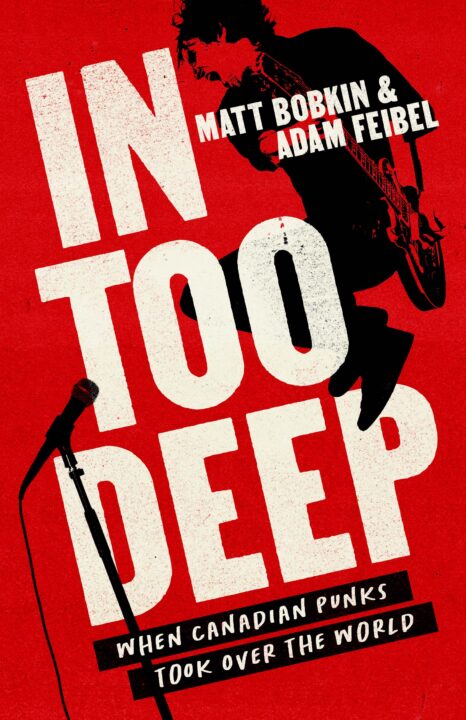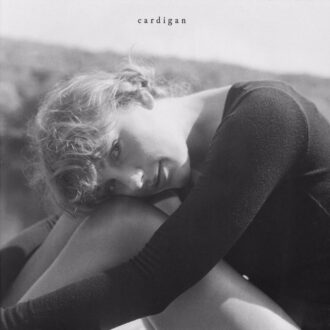Read An Exclusive Excerpt From In Too Deep: When Canadian Punks Took Over The World By Matt Bobkin & Adam Feibel

Below is an excerpt from the upcoming book In Too Deep: When Canadian Punks Took Over The World by Matt Bobkin & Adam Feibel, 2025, published by House of Anansi Press. Reprinted with permission from the publisher.
By the end of the ’90s, punk rock’s time in the mainstream was proving to be more than just a passing fad. Punk bands were reaching bigger audiences and developing a sound that was more melodic and commercially palatable: “pop-punk.” And this new wave already had a forerunner in Blink-182, who were successfully challenging Green Day as rock radio and MTV’s punk band of choice. Blink-182’s knack for catchy melodies, unbridled fondness for sex jokes and toilet humor, and undisguised ambition for stardom was far removed from punk’s traditional anti-establishment ideals. They wrote gag songs about incontinence and incest, and they released a music video of the three bandmates running naked through the streets of Los Angeles. Such behavior made them a prized commodity of mass entertainment, particularly with their third album, Enema Of The State, in 1999. While the album garnered Blink-182 a good share of critics — many of them punk rockers who heatedly contended that the group was nothing more than the Backstreet Boys of punk rock — it went quadruple-platinum in less than a year and turned them into icons.
So when Island signed Sum 41 to a major recording contract the same year that Enema Of The State blew up, they had a clear blueprint of what success would look like for the Canadian teens. And if Sum 41 wanted to feed the appetite for pop-punk before listeners got their fill somewhere else, they had to act quickly. The band headed back into Metalworks in early 2000 to record their first proper release, an eleven-song EP called Half Hour Of Power that reproduced the exact thirty-minute setlist they had been playing at their shows.
Kicking off with a minute of thrash metal riffage, Half Hour Of Power wastes no time showing off the band’s eclectic interests. There are power chords, guitar solos, tight doo-wop harmonies, fake vomiting, and screaming — and that’s only the second track, “Machine Gun.” Near the end of the EP, the chugging guitars of “Dave’s Possessed Hair” abruptly give way to “It’s What We’re All About,” featuring Beastie Boys–style rap trade-offs between Whibley, Jocz, and Baksh, which in turn transitions seamlessly into heavy metal flareup “Ride The Chariot To The Devil.” Though still a pop-punk recording at heart, Half Hour Of Power showed off a surprising amount of versatility and was in keeping with the band’s penchant for relentless thrill-seeking and sky-high ambitions.
If there had been any lingering doubts that Aquarius wasn’t as perfect a fit for Sum 41 as Island, it was put to rest when the Canadian label arranged for the band to launch Half Hour Of Power at Zanzibar, one of Toronto’s most iconic strip clubs. The quartet hit the stage and stripped down to thongs and little else — a bowtie for Jocz, a cowboy hat for Whibley, and a shaggy black wig for McCaslin. Baksh was the most conservatively dressed, being the only one to cover his chest, which he did with a breastplate printed to make him look like a busty, bikini-clad lady. When they turned around, the crowd could see they had written “Aquarius” on their butt cheeks.
When Half Hour Of Power was released to music stores in late June 2000, the EP performed modestly, sneaking onto the charts in the U.S., the U.K., and Japan. The single “Makes No Difference” had the biggest impact, landing in comedy movies like Bring It On and National Lampoon’s Van Wilder and the MTV animated series Daria. For the music video, the label even managed to get rapper DMX to make a cameo.
Half Hour Of Power didn’t turn Sum 41 into a household name, but it wasn’t really meant to. “There wasn’t a massive push on that album — it was just an introduction,” McCaslin says. “Island really wanted us to tour for about a year and a half to build an underground following.” In that regard, Half Hour Of Power more than succeeded in introducing an unknown Canadian group to a receptive audience and getting them sucked into the machinery of American mass media. Now, it was time to go all in.
Only a few months after Half Hour Of Power was released, Sum 41 headed back into Metalworks to start working with Finn on their debut full-length album. The group had rented the backroom of the Chameleon Café, a small Ajax venue that Whibley and Jocz had persuaded to host local punk shows, and where they had spent their time between tours working on new songs for the record. Progress was slow, and they only had a handful of songs finished by the time they entered the studio with Finn. The producer assured them that once they started recording, inspiration would strike, and the songs would start flowing out of them. But after nearly three months at Metalworks, they barely had any new material for the record. “The problem was we were partying way too much,” Whibley said in a 2019 interview with Alternative Press. “We were nineteen and we’d been given a bunch of money by the record company. And it was our first big record. All we were doing was eating really expensive dinners, going out to strip clubs, and doing whatever we felt like — everything except working, really. There was no writing being done.”
At the end of 2000, the band took a three-month break from the studio and Whibley tried to focus on writing new material. But his living situation and the band’s touring schedule weren’t exactly conducive to productive writing sessions, either. He would write in short spurts whenever and wherever he could while the band was on tour — in green rooms, hotels, the back of the van — and when he’d get home to his parents’ house in Ajax, he’d sit in their car in the freezing cold Canadian winter and write songs with an acoustic guitar and a tape recorder. By March, Whibley had managed to finish four more songs, and the band also added the intro and outro tracks “Introduction To Destruction” and “Pain For Pleasure,” two half-jokey heavy-metal tributes to Iron Maiden’s The Number of the Beast. (Jocz spent a total of ten minutes writing the lyrics to the latter while he was sitting on the toilet.)
When the band was ready to head back into the studio, Island sent them to Cello Studios in Los Angeles. That way, none of their friends would be around to distract them, and they wouldn’t be old enough to go drinking in the bars anyway. At Cello, they finally got some work done. The band was happy, and Finn’s team was impressed. At one point, while listening back to the raw mixes, engineer Joe McGrath remarked, “Jesus, this album is all killer, no filler.” And so the album found its name: All Killer No Filler. It was all coming together nicely. But it was still missing something.
Over a period of several months, Whibley had been slowly cobbling together a song out of several spare parts: a hard-rock riff, a hip-hop verse, a big pop-punk chorus. “The very, very first thing I wrote was the guitar riff,” Whibley said in a 2021 interview with Stereogum. “I didn’t necessarily write it for this idea that I had for this sort of punk-rock-rap kind of thing. I knew I had this old-school rap idea mixed with punk-rock sort of stuff, but I wrote this riff just as a riff. And then I ended up writing a chorus, like, months later. And then I had this verse. And none of them were supposed to be together. They were just separate things that I was writing over time. And then one day it kind of clicked, and I thought, ‘Well, these all kind of work. They’re all around the same tempo, they’re all the same key.’ I changed a few things and made it work, and now all of a sudden, I was like, ‘Okay, I’ve got the rap part, I’ve got a riff, and I’ve got a chorus. But I don’t have the rest of the song.’ And then it took a long time before pieces just kind of came together.” A vision slowly materialized, but Whibley still wasn’t sold on it. “I played it for a few people, friends, and I don’t even think half the band really liked it,” Whibley told Stereogum. “And it wasn’t really like it was this great song that everyone loved. It was kind of like, ‘Meh, it’s kind of stupid-sounding. And are you really gonna rap over it?’”
The one person he convinced was Finn. “That’s your first single,” he told the band. “That’s gonna be a hit.”
That song, “Fat Lip,” is Sum 41’s origin story told in three minutes, distilling Half Hour Of Power’s sugar-high sense of exploration into a tenth of the space; there are spunky guitar riffs, three-man rap bars, fast-paced, palm-muted power chords, and a big, shiny pop chorus. The lyrics are both self-deprecating and snot-nosed, with no shortage of quotable zingers perfect for a generation whose brains had been primed by the likes of American Pie.
“It’s this weird Frankenstein song, and I’m amazed it worked,” Jocz says. “It’s a perfect example of what Sum 41 was. It’s a metal song, it’s a rap song, it’s a punk song. It’s all over the place, because we could never focus on one thing. But somehow we made it work.”
Taking Finn’s advice, the band decided that “Fat Lip” would be the album’s lead single. For the music video, they hired director Marc Klasfeld, who was known at the time for rap videos like Nelly’s “Country Grammar” — which was exactly the type of video Sum 41 wanted. They filmed it over two hot, sunny days in Pomona, California, where the band had already built a decent fan base, even in those early days. Klasfeld got hundreds of punks, freaks, and weirdos to hang out, bounce around, and be funny in front of the camera. The band spent part of the video playing for the mass of people and the other taking part in the chaos and hijinks themselves. After two days, they left the shoot with smiles, sunburns, and no idea if they had made a good music video or not.
Their record labels, though, knew right away. “When we got the video, it was like, ‘This is unbelievable,’” says Renaud, their Aquarius rep. “This video is basically a montage of every subset of kids who feel disenfranchised or not part of the mainstream.”
The first inkling the band got that they had created something special came just after Klasfeld sent them the first cut of the music video. They were in L.A. again and bumped into Joel and Benji Madden of Good Charlotte at their hotel, so they showed it to them. “They were just freaking out. ‘Oh my god! This is such a great music video. You guys are gonna be such huge stars,’” Whibley told Stereogum. “They’re like, ‘This is it. This is the last day we’re gonna know you before you’re famous. You guys are famous now because of this.’”
But by the summer, things started to click. The music video for “Fat Lip” began getting more airplay on MTV and, by mid-July, made it to the top spot on Total Request Live. It would return to number one on TRL several more times throughout the summer, duking it out with NSYNC and the Backstreet Boys for the title of America’s hottest music video.
Then, Sum 41 got another big break when they were invited to perform during the opening slot of MTV’s televised twentieth-anniversary party on the first day of August. True to form, they decided to make the most of it.
“We’re gonna be on MTV for five minutes,” Jocz recalls the group saying. “Nobody is going to give a shit if we just go out and play our song. Let’s do something a little different.”
With MTV’s help, the band recruited Mötley Crüe’s Tommy Lee and Judas Priest’s Rob Halford to join the stage with them as they performed a medley of “Fat Lip,” the Beastie Boys’ “No Sleep Till Brooklyn,” Mötley Crüe’s “Shout At The Devil,” and Judas Priest’s “You’ve Got Another Thing Comin’.” The crowd was electric, feeding off the energy of the pop-punk youngsters and the star power of the ’80s metal veterans. As countless viewers watched the live TV broadcast, the band showed off their larger-than-life stage presence and flexed their credibility by not only paying tribute to their influences but getting an unmistakable co-sign from two of the biggest stars of heavy metal’s glory days.
“Getting Rob Halford and Tommy Lee on that stage garnered some kind of respect for us,” McCaslin says now. “There were a ton of haters back then. That just came with the territory. But there were fewer after we did that. At that point, you had Blink-182 and Green Day and the Offspring, and no one in that genre had really dived into the metal thing. We’ve always been big metal fans, and hip-hop fans, and punk fans. People think of metal in a different way than they think of a pop-punk band, so I think bringing metal into the fold, people were like, ‘Oh, they can play metal. That’s tough!’ I think the respect came from that.”
When Sum 41 returned to the Warped Tour, everyone — well, everyone but them — knew things had changed. “The bands we knew were like, ‘You guys are about to be superstars.’” Whibley said in a 2021 interview with Billboard. “We’re like, ‘What? What are you talking about?’ They’re like, ‘You have no idea what’s about to happen.’”
Suddenly, Sum 41 wasn’t just successful — they were, indeed, superstars. Within weeks, “Fat Lip” was being played everywhere. The song broke out of MTV and into the stratosphere. It charted in twelve countries, hitting No. 1 on the U.S. Alternative Airplay chart and the top 10 on the U.K. singles chart. By the end of August, All Killer No Filler was certified platinum.
Following the summer of 2001, Sum 41 continued to be MTV favourites. Just in time for a new school year, they dropped a new music video for “In Too Deep,” a parody of a scene from the Rodney Dangerfield movie Back To School. In the video, the scrawny members of Sum 41 arrive at a pool lined with palm trees in sunny California to compete in a diving competition against a team of muscular, tanned, Speedo-wearing jocks. In its most iconic moment, Baksh rises out of the water, godlike, to rip his guitar solo in an homage to Slash of Guns N’ Roses. The music video became an instant classic of its own, further establishing Sum 41 as poster boys of a pop-cultural movement defined by teen movies, pop-punk jams, and rock ’n’ roll idolatry. “In Too Deep” would go down as arguably Sum 41’s most popular song, and with it, the band proved that they weren’t just riding a wave — they were the wave.
Very quickly, Sum 41 cultivated a fervent fan base that fully bought into their “fuck you” attitude and would gleefully attend their live shows to display the Sum 41 salute: four fingers extended on one hand and the middle finger on the other. “It’s great to see punk rock with personality,” Blink-182’s Tom DeLonge told a Rolling Stone writer while backstage when Sum 41 was opening for them at a gig in Toronto that drew a reported ten thousand people. The band members’ previously hesitant parents showed up to their local shows in their cars now with custom licence plates: SUM41DAD, SUM41MUM, and SUM41ROX. Whibley’s mother even followed them on tour, including a memorable flight to Japan where they “drank the plane dry and kept getting kicked out of first class,” as she later told the Canadian Press. Sum 41 had burst out of the quiet streets of Ajax and sought salvation in drunken debauchery and devilish destruction — now, they were being handsomely rewarded for it.







